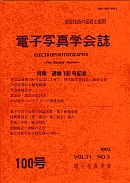Volume 34, Issue 4
Displaying 1-8 of 8 articles from this issue
- |<
- <
- 1
- >
- >|
Original Articles
-
1995 Volume 34 Issue 4 Pages 312-319
Published: 1995
Released on J-STAGE: April 06, 2007
Download PDF (2728K) -
1995 Volume 34 Issue 4 Pages 320-327
Published: 1995
Released on J-STAGE: April 06, 2007
Download PDF (3242K) -
1995 Volume 34 Issue 4 Pages 328-336
Published: 1995
Released on J-STAGE: April 06, 2007
Download PDF (2666K)
Imaging Today
“Murti-media and Hardcopy Technoligy”
“Murti-media and Hardcopy Technoligy”
-
1995 Volume 34 Issue 4 Pages 338-344
Published: 1995
Released on J-STAGE: April 06, 2007
Download PDF (2038K) -
1995 Volume 34 Issue 4 Pages 345-349
Published: 1995
Released on J-STAGE: April 06, 2007
Download PDF (1500K) -
1995 Volume 34 Issue 4 Pages 350-358
Published: 1995
Released on J-STAGE: April 06, 2007
Download PDF (1781K) -
1995 Volume 34 Issue 4 Pages 359-364
Published: 1995
Released on J-STAGE: April 06, 2007
Download PDF (1885K) -
1995 Volume 34 Issue 4 Pages 365-370
Published: 1995
Released on J-STAGE: April 06, 2007
Download PDF (2414K)
- |<
- <
- 1
- >
- >|
